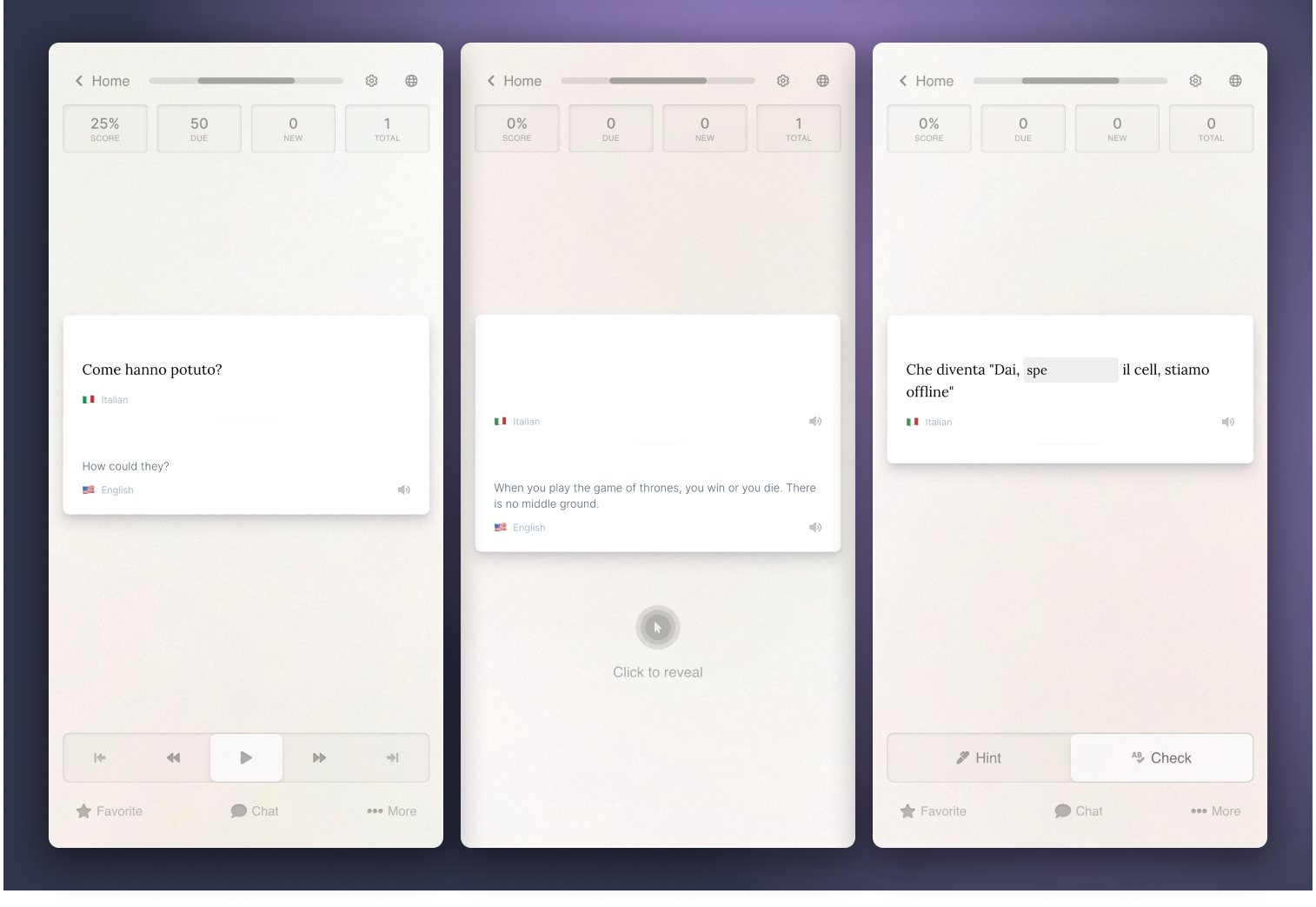Active Recall and Spaced Repetition Techniques Explained
Master language learning with Active Recall and Spaced Repetition. Phrasing optimizes these techniques for efficient vocabulary acquisition. Boost your active vocabulary, go beyond understanding to applying languages effectively. Seamlessly integrate learning into your routine with Phrasing

As we step into the globalized world, the skill of mastering multiple languages has increasingly gained importance. The key to acquiring a new language doesn't merely lie within constant practice — it also involves an intricate interplay of memory retention and recall strategies.
While there are a thousands wrong ways to learn a language, there are also many different right ways to learn a language. Understanding the different between the right ways to learn a language will help you focus on the skills you need.
Passive Recall vs. Active Recall
When we talk, we use two types of vocabulary: active and passive. Your active vocabulary includes the words you use every day when you talk. On the other hand, your passive vocabulary includes words that you understand when you hear them, but you don't often use when speaking.
Have you ever heard a word and knew what it meant in the sentence, but couldn't define it if asked? That's your passive vocabulary at work.

Understanding both forms of recall, active and passive, is important when learning a language. Passive recall is all about understanding a language. Active vocabulary use is harder because it's about using the right word at the right time.
Spaced Repetition Algorithms
Spaced Repetition Algorithms were popularized in the 1990s by Piotr Wozniak, a pioneer in learning methodologies, with his app SuperMemo, which he claims allows you to "master information at the fastest possible speeds".
"With SuperMemo, you can master information at the fastest possible speed."- Piotr Wozniak
Since then, spaced repetition algorithms have come a long way. They've become more efficient, handled more cases, and proven to be effective in a wide range of fields, beyond language learning.
Popular apps like Anki have been essential to linguists, students, and doctors all around the world.

At Phrasing, we've developed our own Spaced Repetition Algorithm, based off of Piotr Wozniak's foundational work (namely his DSR system) but have fine tuned it to language learning.
Spaced Repetition Study Methods
Stephen Krashen, a widely recognized linguist, has made significant strides in understanding the dynamics of language acquisition. In essence, he noted: "Language acquisition does not require extensive use of conscious grammatical rules, and does not require tedious drill." This alludes to our understanding of passive recall, where understanding a language plays a major role, rather than arduous memorization practices.
"Language acquisition does not require extensive use of conscious grammatical rules, and does not require tedious drill."- Steven Krashen
Now, Stephen Krashen sounds like he probably would not love Spaced Repetition based study methods. But has he ever tried Phrasing? No!
At Phrasing, we've optimized our spaced repetition study method to be based around comprehensible input. Throw away the grammar rules, tedious drilling, and random vocabulary. We provide you with little snippets of comprehensible input all day, related to content you consume, working your way to the point where you can use any native material as comprehensible input, no matter it's niche or level.
How Do You Combine Active Recall with Spaced Repetition?
To increase your active recall with spaced repetition, all you need to do is set up your target language as your input language. With Phrasing, choose any review methodology (flashcards, cloze, shadowing) and configure the language you want to increase your active recall in as your target language.

•Using a target language as an input can be a challenging task. The complexity arises as this method requires not only passive understanding but also the active production of the language. This may be demanding as it involves significant mental effort in consistently formulating coherent sentences and responses. However, despite its difficulty, this approach provides a much more practical, real-world understanding of language application.
•This approach requires the learner to actively produce the language, which may limit the quantity of new words learned in a certain period compared to passive learning. The emphasis in active recall is on the quality of learning, understanding context, and usage, rather than sheer volume of vocabulary. Thus, while the pace might be slower in terms of words learned, the depth of understanding and ability to use those words effectively can be greatly enhanced.
•In active learning, you're not just passively acquiring information but consciously managing to retrieve it through production. This enhances your ability to construct coherent sentences, and express and exchange ideas clearly. Consequently, your discussions about the material consumed in the target language become more fluid and natural, enabling more meaningful and engaging interactions with others.
Maximize Passive Recall with Spaced Repetition

To increase your passive recall with spaced repetition, configure your target language as your source language. This way, you can expose yourself to as much of your target language as possible, and not concern yourself with active recall. By doing so, you'll reach a point of comprehension of native materials far quicker, where you can start to really acquire a language through comprehensible input.
Once you can start learning through comprehensible input, you'll be off to the races, since as we learned from Steven Krashen, comprehensible input is the only way to acquire a language.
Until then, focus on building your passive recall with Phrasing.app The iterative exposure to the target language ingrains it deeper in your memory each time, and as the repetition is intelligently spaced, it ensures maximum retention. Most importantly, by choosing the content you'd like to learn from ahead of time, you'll only be learning that which is essential for comprehension!
Balanced Recall with Spaced Repetition
While it may seem like you want to always improve your active recall, this is not always the case. Remember, language learning takes place when you're consuming comprehensible input. Increasing your passive vocabulary to the point you can consume material and follow along is the fastest route to fluency
However, if you know what subjects you want to be able to talk about, studying your active recall can be a very targeted and efficient way to flush out your language islands.
Applying Balanced Recall to Language Learning
Gaining proficiency in multiple languages is crucial in the globalized world, not simply through constant practice, but through strategic use of memory retention and recall strategies. Understanding frames of recall, such as active recall (words used in everyday conversation) and passive recall (words understood but rarely used), significantly aids language learning.
By using target language as input, active recall can indeed challenge the learner but imparts a practical understanding and application of the language. On the other hand, setting target language as a source optimizes passive recall, fostering a more grounded understanding of the language and speeding up the learning process through pattern recognition and repetition.
To genuinely ameliorate fluency, a balance (rather than an exclusive focus on active recall) should be achieved, which refines language consumption via comprehensible input and empowers learners to discuss chosen subjects with efficiency.
Best Spaced Repetition App for Language Learning
The advancement of technology has presented a new, efficient way to learn languages - the spaced repetition method. This system involves reviewing information at increasing intervals over time, allowing the learning process to become more manageable and effective.

Phrasing.app
To fluency, and beyond
Phrasing nails language learning with precision-focused materials, actionable insights, and user-friendly settings. Standouts:
- Tailored lessons: keep any material in the desired difficulty.
- Focused content: focus on the essentials to comprehension of what really matters.
- Customizable review: Target active, passive, or balanced recall for any myriad of languages.
Accelerate toward fluency using Phrasing, perfect for both active and passive vocabulary.
